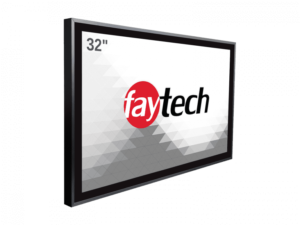Remember when we had to physically press buttons to get our devices to do something? Sensors are already replacing buttons, and membrane switches in a wide range of consumer electronic products, from smartphones, tablets, capacitive touch screen displays to other comparable devices, thanks to capacitive touch technology. But, first, we’ll go over how the technology works and how to use them.
Capacitance-based touch sensors convert a surface area into several sensing opportunities by using an electrostatic field and sensing minute changes in the capacitive field. Sensors like these can detect and quantify anything conductive or has a different dielectric than air, allowing for non-mechanical methods of receiving stimuli.


While touch sensors have been present for a long time, recent advancements have made capacitive-based sensors a viable replacement for buttons and mechanical switches in a wide range of consumer products.
Since the launch of the first touch phone, touch sensing technology has altered how we engage with machines of all types in our surroundings. Touchscreens are used as input devices in computer trackpads, digital audio players, smartphones, and tablets by leveraging capacitive sensing technology.
A capacitive touch sensor, at least two complementary semiconductor integrated circuit (IC) chips, an application-specific IC controller, and a digital signal processor (DSP) are common components of such touchscreens.
Capacitive sensing capabilities have grown relatively common within microcontrollers as a result of technological advancements. In many cases, the technology is now available off the shelf for many microcontrollers on the market. This frees engineers from worrying about innards and algorithms of signal processing, timing, and circuitry. Instead, out-of-the-box technology can detect the actual capacitive change measured in femtofarads (fF), which are exceedingly small units.
Today, people can control products with the help of capacitive sensors. They turn flat or curved surfaces into keyboards, adjust the volume, and perform whatever the user interface includes. Various sensors use capacitive sensing to induce all the actions. All these actions are prompted by capacitive sensors, from proximity, pressure, location, humidity, and fluid level to acceleration.
This is where you need us, capacitive sensing can occasionally be more of an art than a science, and we have been doing it for a while at faytech. However, we’ve learned a lot from our previous projects, and we know how to use the technology successfully.
One such example is our 10.1 capacitive touch screen monitor, which has proved to be a perfect interactive solution for digital signage, classrooms, meeting rooms, industrial automation, shopping malls, hotels, and many other areas.

Give us a call to learn more about how we can help you bring your next gadget project to life with capacitive sensing and other cutting-edge technology.
 faytech AG
faytech AG faytech AGUpcoming Exhibitions (October) & Holiday Notice
Scroll to top
faytech AGUpcoming Exhibitions (October) & Holiday Notice
Scroll to top
We may request cookies to be set on your device. We use cookies to let us know when you visit our websites, how you interact with us, to enrich your user experience, and to customize your relationship with our website.
Click on the different category headings to find out more. You can also change some of your preferences. Note that blocking some types of cookies may impact your experience on our websites and the services we are able to offer.
These cookies are strictly necessary to provide you with services available through our website and to use some of its features.
Because these cookies are strictly necessary to deliver the website, refusing them will have impact how our site functions. You always can block or delete cookies by changing your browser settings and force blocking all cookies on this website. But this will always prompt you to accept/refuse cookies when revisiting our site.
We fully respect if you want to refuse cookies but to avoid asking you again and again kindly allow us to store a cookie for that. You are free to opt out any time or opt in for other cookies to get a better experience. If you refuse cookies we will remove all set cookies in our domain.
We provide you with a list of stored cookies on your computer in our domain so you can check what we stored. Due to security reasons we are not able to show or modify cookies from other domains. You can check these in your browser security settings.
These cookies collect information that is used either in aggregate form to help us understand how our website is being used or how effective our marketing campaigns are, or to help us customize our website and application for you in order to enhance your experience.
If you do not want that we track your visit to our site you can disable tracking in your browser here:
We also use different external services like Google Webfonts, Google Maps, and external Video providers. Since these providers may collect personal data like your IP address we allow you to block them here. Please be aware that this might heavily reduce the functionality and appearance of our site. Changes will take effect once you reload the page.
Google Webfont Settings:
Google Map Settings:
Google reCaptcha Settings:
Vimeo and Youtube video embeds:
The following cookies are also needed - You can choose if you want to allow them:
You can read about our cookies and privacy settings in detail on our Privacy Policy Page.
Privacy Statement faytech AG
faytech AG



